Crumb crusts are a quick and simple alternative to traditional pie crusts. They require only a few ingredients and just minutes to assemble, and the possibilities for creating different flavor variations are endless. Learn how to make a crumb crust for pie with this comprehensive tutorial!
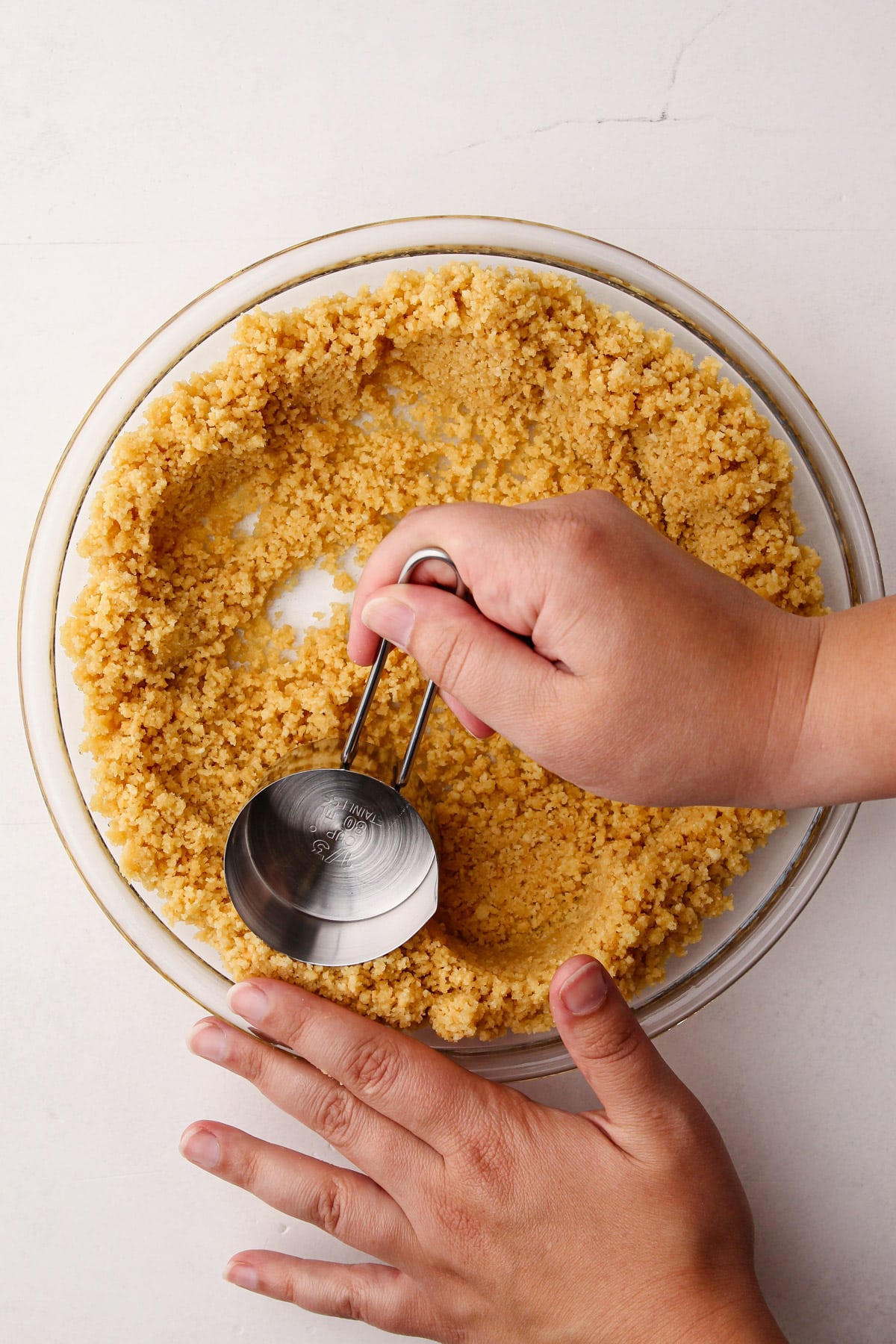
Want to save this recipe?
Enter your email & I'll send it to your inbox. Plus, get weekly updates from me!
Sometimes you need a super easy, no-brainer type of pie crust. A crumb crust is a great option for those moments! The most common type of crumb crust is probably a Graham Cracker Crumb Crust. But the truth is they can be made from a wide range of crumbs made from cookies (like this Biscoff Pie Crust), crackers like this saltine pie crust used in this Butterscotch Cream Pie), cereal, pretzels, or even potato chips (like this potato chip pie crust in this Nutella Pie). Usually, sugar is added, though not always, and some additional ingredients are occasionally added to create a fun flavor.
Crumb crusts are entirely customizable once you know the formula and best practices for making them! This guide on How to Make a Crumb Crust for Pies will detail all the information you need to be successful and creative in making the perfect crumb crust.
Ingredient Options for a Crumb Crust
Typically, most crumb crust recipes have 3-4 basic ingredients:
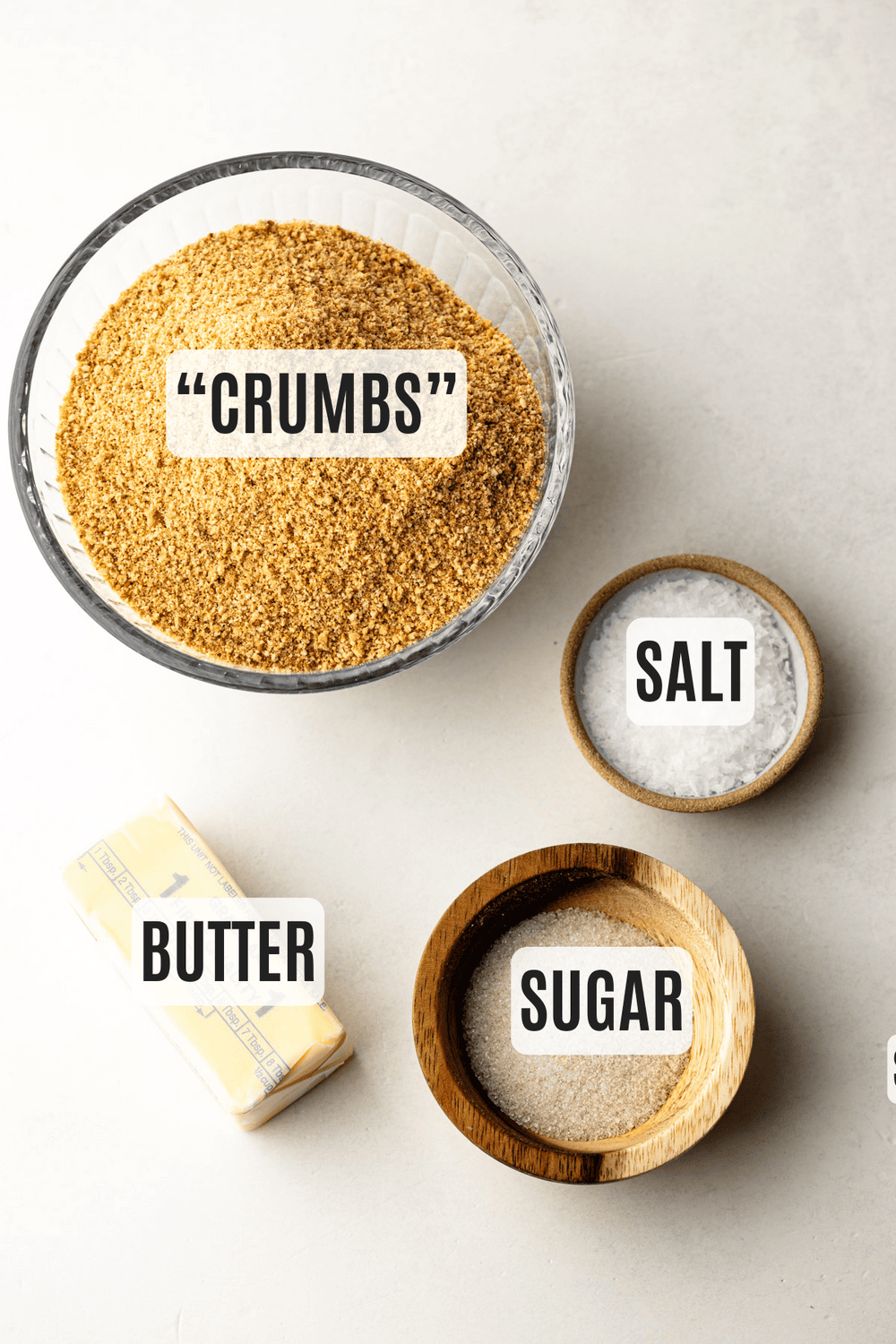
- crumbs
- sugar (this is optional, see more info below)
- melted butter
- salt (just a pinch will do the trick to help amplify the flavor of the pie crust
Options For the Crumbs
Basically, if you can crumb it, you can make a pie crust out of it! When choosing ingredients for a crumb crust base, consider some of the characteristics that make an ideal pie crust:
- The ingredient you choose as the base should have a dry texture, which will help result in a crunchy crumb crust.
- Avoid soft or stale foods.
- Think about the ingredient's flavor and ensure that it will complement the overall flavor of the pie. It's okay if it's a contrasting flavor from the filling, but the crust should add to the overall pie, not overpower it.
- Make sure to factor in the added sweetness that the crumb crust will add to the pie, and adjust accordingly (See below for more about adding sugar to crumb crusts.)
- Avoid using super-greasy ingredients as the base for your crumbs, such as high-fat cookies (shortbread is one of these cookies, and while it can definitely be used, you’ll need to adjust the amount of butter added to it).
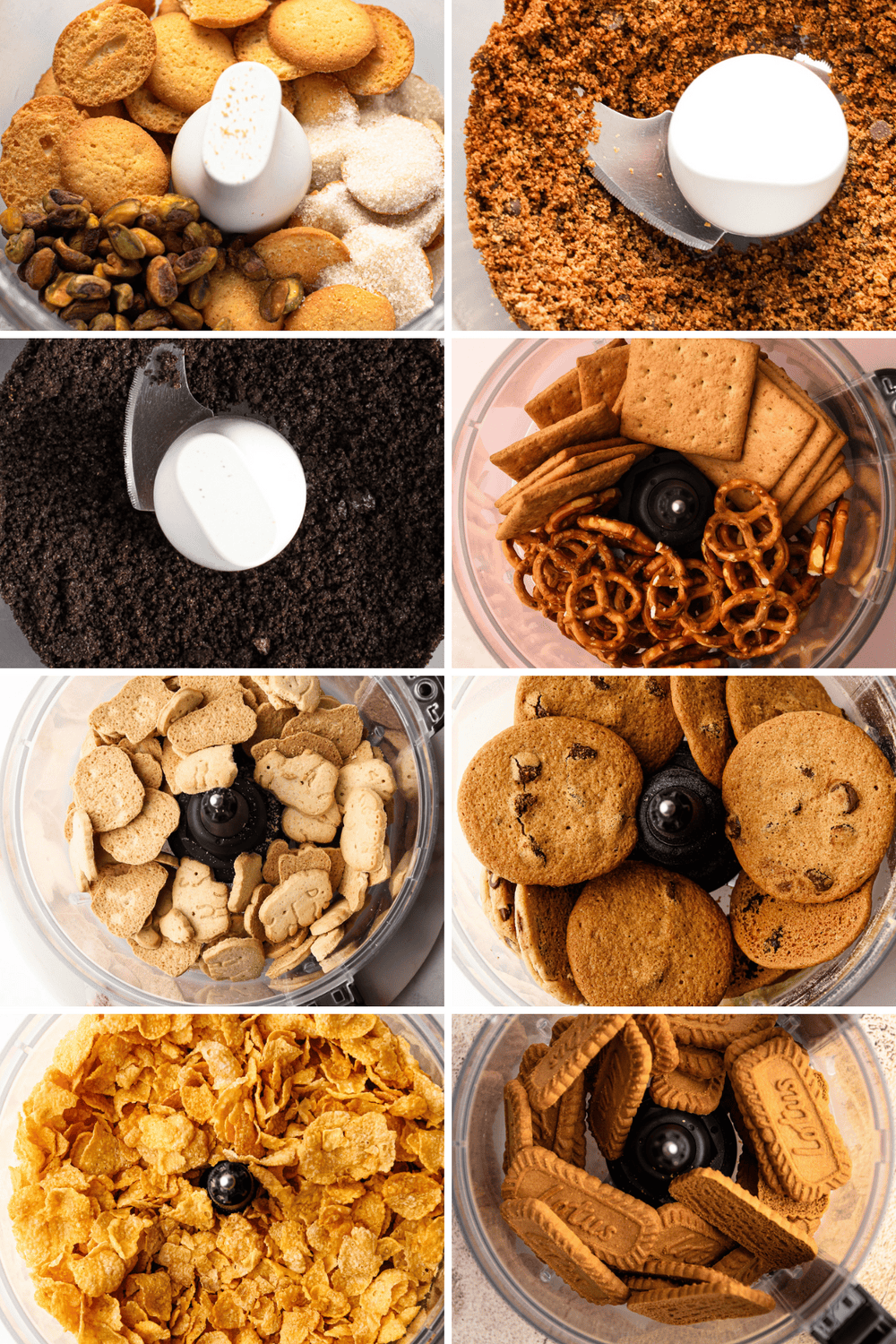
Here are some options to use as the base of a crumb crust
Cookies: Sandwich cookies (like Oreos or their vanilla counterpart), graham crackers, vanilla wafers, dry chocolate chip cookies, or any other semi-dry, flavored cookie, like biscoff or gingersnaps.
Crackers: Animal crackers work well, but think outside the box and venture over to savory options like saltines or butter crackers to add a salty component.
Cereal: The sky’s the limit when it comes to using breakfast cereal! Anything from Corn Flakes to Cheerios to Grape-Nuts would be a good choice. Granola or even plain oats can work, too, though it’s best to use oats in combination with another type of crumb.
Pretzels: Any size pretzel will work, whether salted or unsalted.
Potato Chips: Go for a kettle-cooked variety because of their crunch factor, It’s best to stick with a plain salted chip to avoid competing flavors with the pie filling.
Ice Cream Cones: Got broken ice cream cones? Crunch them up and use them here!
Nuts: You can use just about any nut to make a pie crust, though it’s best to add another ingredient to the nuts to make the crust a better texture. Think of nuts as more of an add-in rather than the whole of the crumbs, though this gluten-free Faux Oreo Crust is a good example of a nut crust.
To Add Sugar, or Not to Add Sugar
Sugar provides sweetness, adds depth of flavor when it’s baked, and contributes to a crumb crust’s integrity by melting and then solidifying after baking. Depending on the type of pie you are making, adding sugar to the crumbs is optional. Some crumb bases, like Oreos or shortbread cookies, already have a lot of sugar in them, so technically they don’t need any added sweetening. And for recipes that already have a rather sweet filling, adding sugar to the crumb crust might just be too much. (One example is this Candy Cane Pie, which has a very sweet filling and therefore doesn't call for adding any sugar to the pie crust.)
However, sugar does more than sweeten the crumb crust. Adding sugar to a crumb crust creates a sturdier pie and a prettier slice.
So, while you can technically omit the sugar, it is often added to make the crust more sturdy. Be aware that the crust will be a bit more crumbly if it doesn't include added sugar.
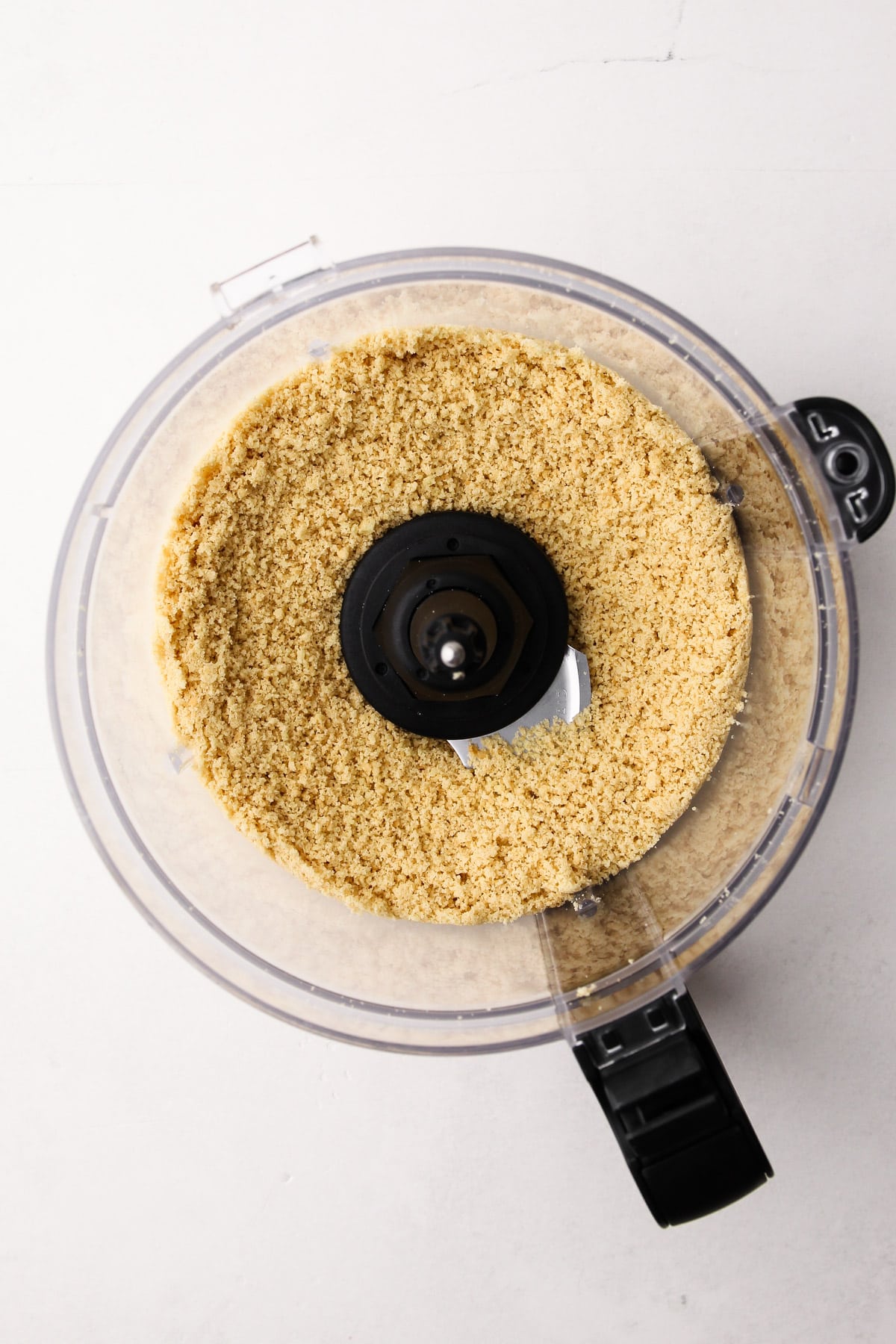
How To Make the Crumbs
It is possible to buy pre-made cookie crumbs at the grocery store, such as graham cracker crumbs or Biscoff cookie crumbs. But, for the most part, you'll usually need to pulverize the ingredients for your crumb base at home, and there are two main ways to do that:
Using a food processor or a blender is the easiest method, swiftly transforming cookies, crackers, or cereal into fine crumbs with a consistent texture. However, some people find cleaning up a food processor to be an annoying chore.
Smashing the crumbs by hand is also an option. The neatest way to do this is to place the ingredients in a zipper-lock bag, press out all the air and seal, and then pound everything into crumbs with a rolling pin or meat pounder. While this method is pretty straightforward, it has its own disadvantages. It requires some manual labor, can result in an uneven crumb texture, and might be time-consuming depending on what you are crushing up.
Whichever way you make the crumbs, aim for crumbs that are about the size of grains of sand, with as much evenness as possible. Some variation in texture is okay, but keep in mind that uneven pieces can result in a less-than-sturdy crust.
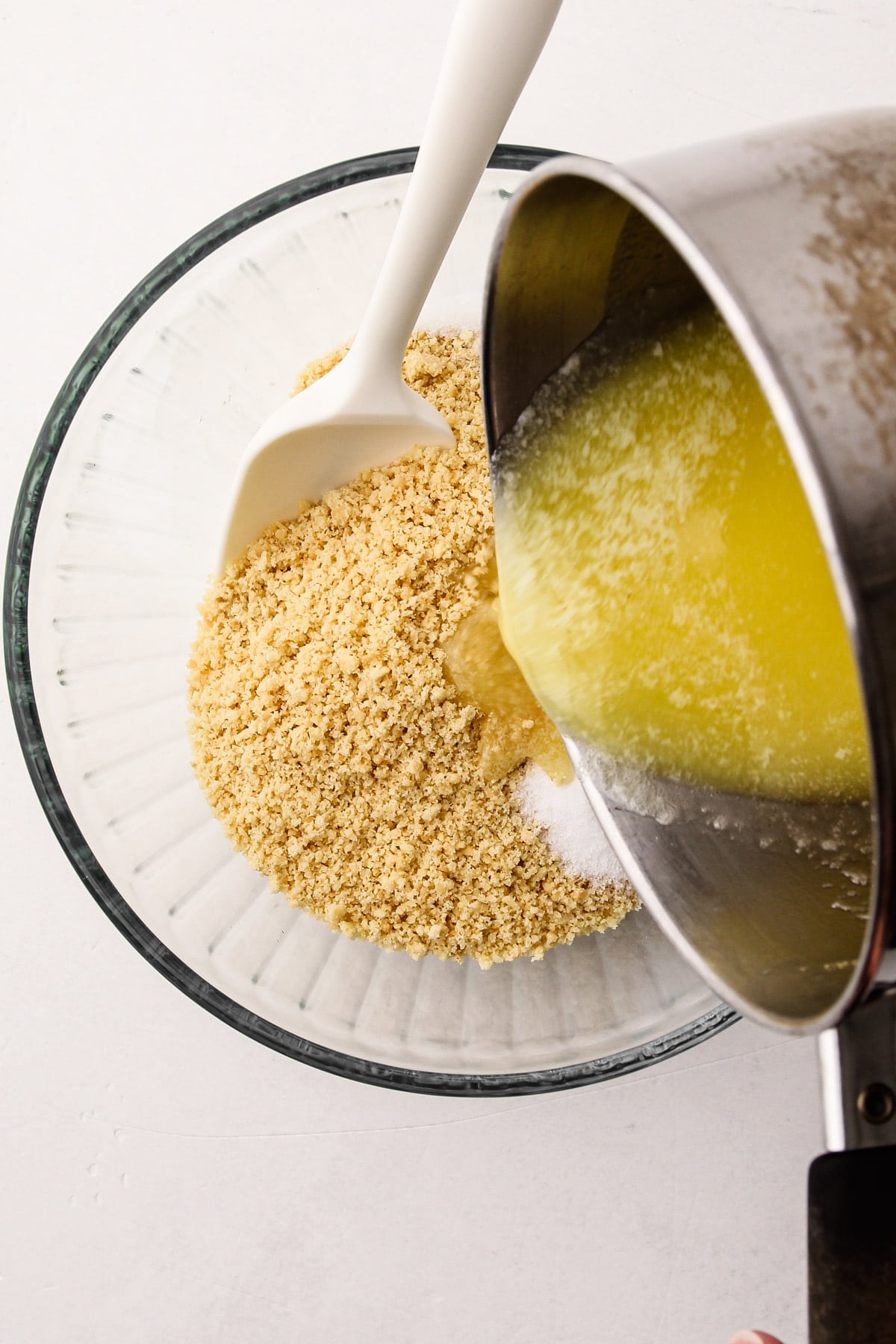
How To Gauge the Amount of Butter Needed
The melted butter in a crumb crust adds richness and flavor and contributes to the crust’s crispy texture when baked. There will always be some nuance in how much butter you need to add to the crumbs, even if a recipe gives you a specific amount of butter. This is because various brands of products like cookies or crackers will have varying moisture and fat levels. For example, some brands or shapes of pretzels will be more dry than others. And I learned first-hand that different brands of chocolate sandwich cookies will vary drastically with how much butter is needed to adequately hydrate the crumb mixture.
When making a crumb crust, it's good practice to start by adding a small amount of butter to the crumbs at first, then add more as needed. Additionally, it's useful to keep extra crumbs on hand in case the mixture gets too wet. The correct texture for the crumb mixture should be the consistency of wet sand. When you squeeze a small amount of the mixture in your hand, it should hold together and compact easily without crumbling apart, but not feel sticky or greasy..
If, for any reason, your crumb crust is extremely dry, you can add more melted butter–one tablespoon at a time–to the crumbs until they are evenly moistened. Alternatively, if your mixture is too wet and hard to work with, add more crumbs until the mixture is a bit drier, but still moist enough for the crumbs to stick together easily.
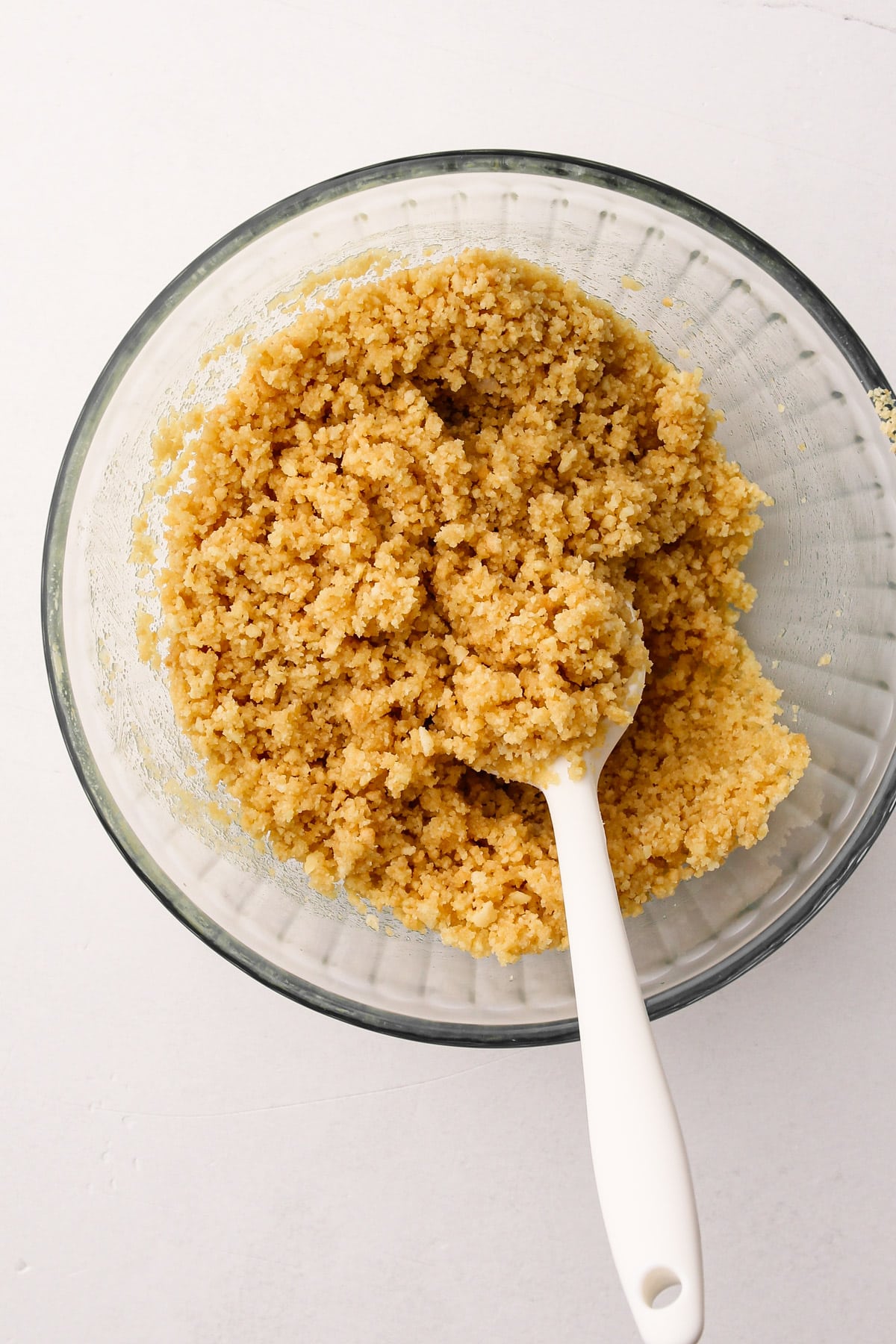
How to Form a Crumb Crust
Back when I had my baking company, I hardly ever included crumb crusts in my pie menu. I used to think they were messy and fussy to press into the pan. That all changed when I discovered a trick for pressing the crumbs into the pan, and it made all the difference in the world.
While logic might tell you to first place the crumb mixture into the middle of your pie plate, then start pressing it in and up the sides, that actually makes the process messy and difficult to get an even crumb base up the sides of the pan.
The easier and faster way to shape a crumb crust is to start forming the edges of the pie crust first, then press the crumb mixture down into the bottom of the plate.
Here is a visual overview:
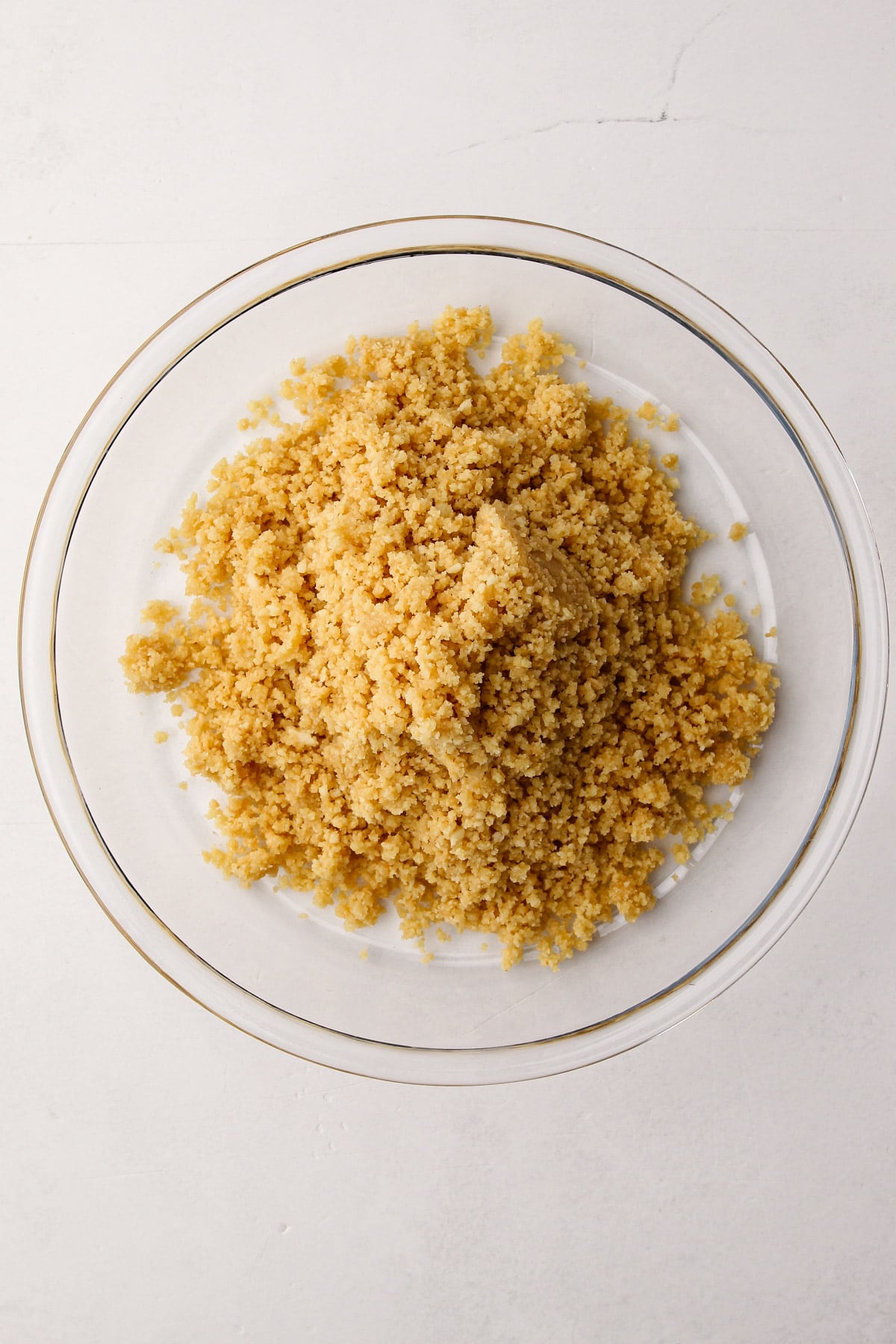
Step 1: Pour the crumb mixture into the pie plate.
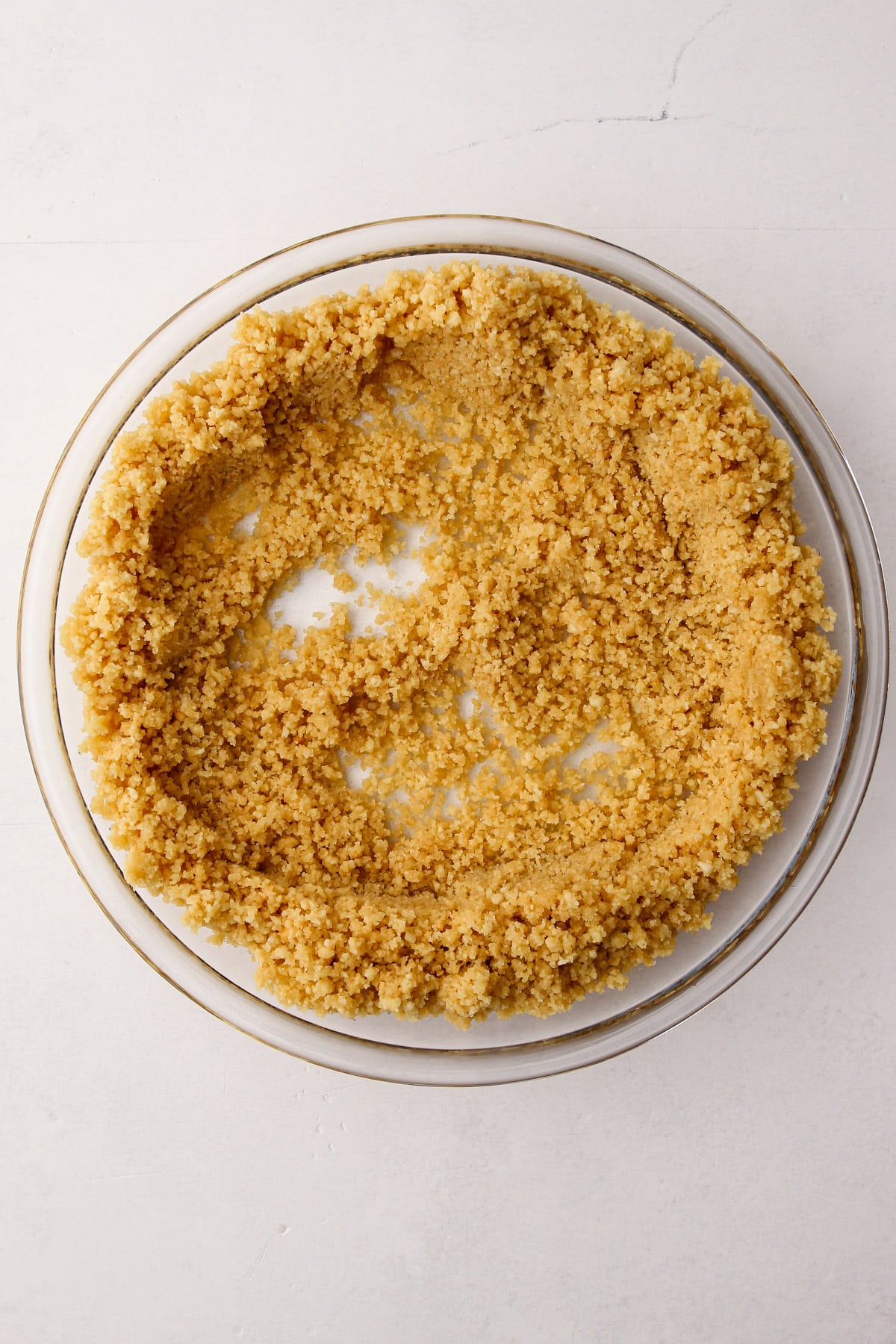
Step 2: Gather the crumb mixture loosely around and up the sides of the plate, then form the top edges of the crust and neaten them by pressing them together with two fingers.

Step 3: Next, start packing down the sides of the crumb crust against the pie plate in an even layer with your thumb. As you do this, start moving the excess crumb mixture toward the center of the pie plate.

Step 4: Continue packing the crumbs from the outer edges towards the middle until you have a single layer. Then with your fingers, a spatula, or the bottom of a measuring cup, pack down the crumbs until everything is tight and even.
To Freeze or To Bake
Once the crumb crust is formed, you have two options: You can par-bake it or freeze it before adding the filling. Each option has pros and cons. Both the butter and the sugar play important roles in ensuring the crumb crust stays together.
Freezing a crumb crust works because the melted butter solidifies as it cools and bonds the crust together. But without the par-bake, the sugar usually won't melt enough to act as a binding agent here.
While freezing the crust is easier than preheating an oven and par-baking it, a frozen crumb crust is not as sturdy as the baked version. I only recommend freezing the crust if you will be serving your pie very cold. Otherwise, your crumb crust will be very crumbly! If you plan to freeze the crust, make sure to grease the bottom of the pie plate with nonstick cooking spray before shaping it. This will ensure that the pie slices come out easily.
When a crumb crust is baked, the sugar melts, helping to bond the crust. Baking results in a crisper crust, and also toasts the crumbs, deepening the pie's flavor.
I prefer the par-baking method and will always bake a crumb crust if I can. If you are making a pie recipe that will be served after being left out of the refrigerator for more than 20 minutes, I recommend that you par-bake the crust to ensure it holds together.
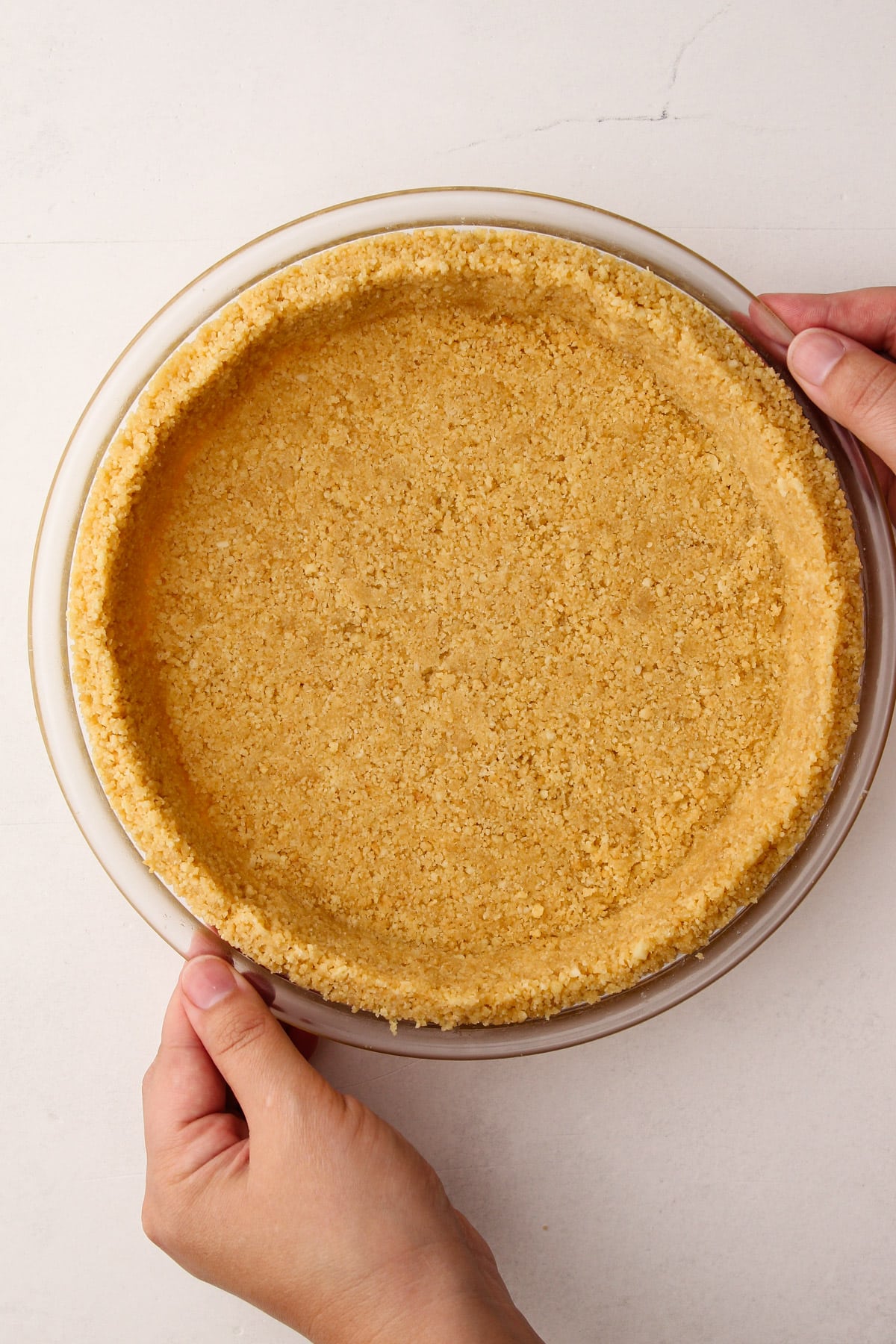
What Types of Pie Are Best For a Crumb Crust?
- No-bake cheesecake style pies (such as this Candy Cane Pie, Nutella Pie with Potato Chip Crust, or this Orange Creamsicle Pie)
- Pudding pies, aka cream pies (like Chocolate Cream Pie, Banana Cream Pie or Pistachio Cream Pie)
- Ice cream pies (like this Baked Alaska Pie)
- Thicker custard / baked cheesecake pies (such as this Strawberry Cream Cheese Pie, Cinnamon Pie or Roasted Plum Pie)
- And, of course, anything chocolate is always a good choice (like Malted Milk Chocolate Pie, French Silk Pie or Mint Chocolate Chip Pie)
The only type of pie that doesn't work as well with a crumb crust is a loose custard pie. Custard pie recipes generally have a lot of liquid, and sometimes, when you pour a thin filling into a crumb crust, the crumbs break apart and rise to the top of the pie. While I've had some success with it, you should take special steps (like making a really thick, well-packed down crumb mixture), such as discussed in this Key Lime Pie recipe.
Now it's time to get creative and make your own crumb crust! Use the ratio and instructions in the recipe below to get started!
More Kitchen Tutorials
Full Recipe
How to Make a Crumb Crust
Crumb crusts are a quick and simple alternative to traditional pie crusts. They require only a few ingredients and just minutes to assemble, and the possibilities for creating different flavor variations are endless. Use this ratio to help you get started making your own crumb crust, and check out the article above for a comprehensive crumb crust tutorial!
- Prep Time: 00:05
- Cook Time: 00:10
- Total Time: 15 minutes
- Yield: (1) 9-inch crumb pie crust
- Category: Pie Crust
Ingredients
- 8 ounces (227 grams) crumbs (about 2 cups), more as needed
- ¼ cup (50 grams) granulated sugar (optional)
- Pinch salt
- 8 tablespoons unsalted butter, melted, (divided)
Instructions
- In a bowl, mix together the crumbs, sugar, and salt. Start by adding 3 tablespoons of the melted butter, and add more as needed. Usually it needs no more than 8 tablespoons (though very dry crumbs like pretzels can take more). The mixture should be damp, like wet sand, and will hold together when squeezed. If it is too dry, add more melted butter, a tablespoon at a time. If it’s too wet, add a tablespoon more crumbs until it’s the correct consistency.
- Gather the crumb mixture loosely around and up the sides of the plate until all the edges are covered with crumbs.
- Form the top edges of the crust and neaten them by pressing them together with two fingers. It may feel like you won't have enough crumbs to cover the bottom of the pie plate at this point, but don't worry. There will be plenty of crumbs to go around.
- Next, start packing down the sides of the crumb crust against the pie plate in an even layer with your thumb. As you do this, start moving the excess crumb mixture toward the center of the pie plate.
- Continue packing the crumbs from the outer edges towards the middle until you have a single layer.
- Then with your fingers, a spatula, or the bottom of a measuring cup, pack down the crumbs until everything is tight and even.
- The crumb crust can be parbaked in a 350ºF preheated oven for 10 minutes for a more toasted flavor and stable texture, or it can be chilled in the freezer before it is filled.
Notes
The article above this recipe has the bulk of the information needed to successfully create your own crumb crust. Be sure to read through it if you have any lingering questions or you are looking to trouble shoot.
In addition, this website also has many crumb crust recipes already measured out with more specifics if you have a particular crust in mind:
Some of the links on this page may be affiliate links. Everyday Pie is a participant in the Amazon Associates Program. As an Amazon Associate I earn from qualifying purchases, at no extra cost to you.



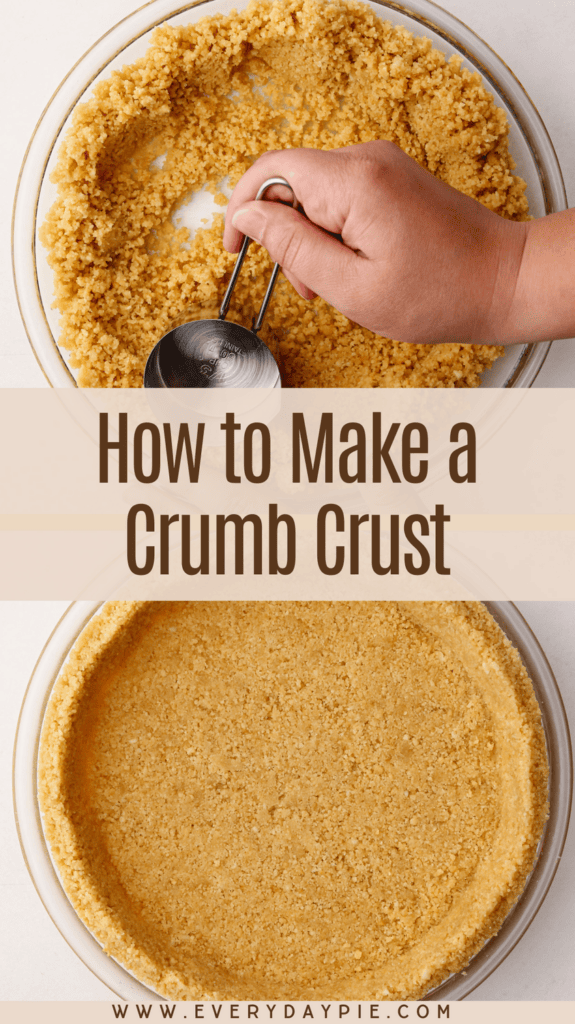
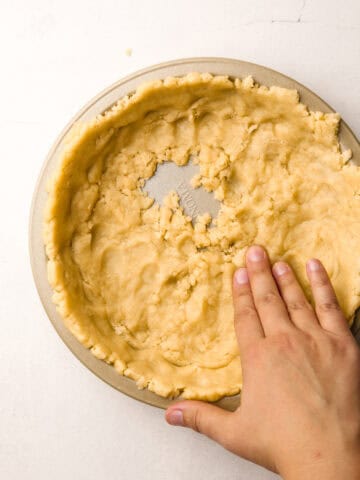
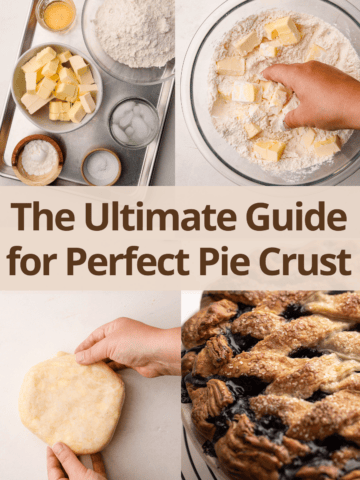
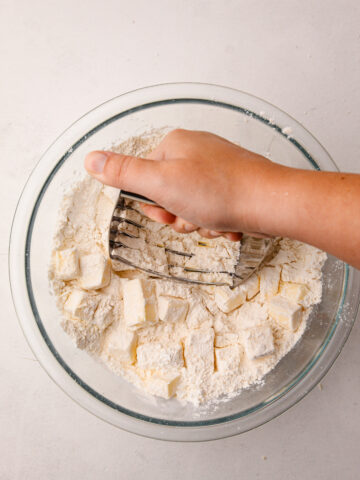
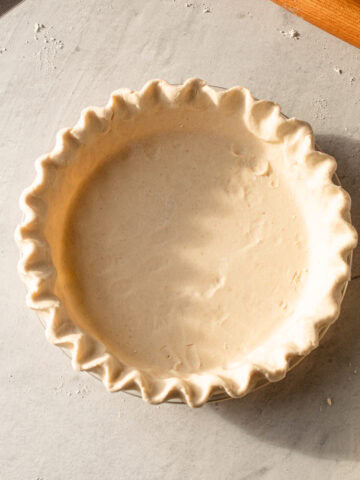
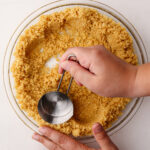
Leave a Reply